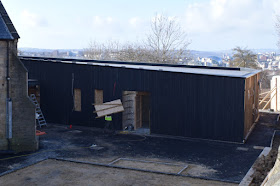The Grade 2 Listed church was built in 1862-63, to the designs of W L Moffat, to serve the burgeoning population as Newcastle expanded with the growth of local industry. Until this time Byker had been a small village, of which nothing now remains, though the church stands roughly on its location. The site was quarried for stone and there were also coal mine workings in and around the hill, which may be partly responsible for the subsidence problems which affected the now demolished church hall.
The church is considered unusual in having been conceived from the beginning on so large and grand a scale for a purely working class community. The original church consisted of nave, south aisle, chancel and vestry, with a tall tower over the entrance porch near the south-west corner. The church was expanded in 1936 by the addition of a gabled north aisle, elongation of the chancel, and the addition of organ chamber, vestry and choir. Material from the recently demolished St. Peters Church, Oxford Street was used.
The church is dominated externally by the tall tower, which stands proud of the rest of the building over the main entrance porch. The broach spire is indeed visible from some distance, and can clearly be seen against the horizon on arrival into Newcastle by train. The tower is 25m (79 feet) in height, of which approximately half is the spire. This has one two-light traceried window with louvres in each broach face. Below this is the belfry stage with pointed triple-lancet windows with louvres. The middle stage has narrow pointed lancets. The lower stage has the main doorway, pointed with nook-shafts and three orders of chamfers. The tower has angle buttresses.
The nave and aisles of the church have separate gabled roofs, and buttresses with two weatherings, as has the chancel. The style of the architectural details is Decorated, with the exception of the 1936 additions which are Perpendicular, with small square headed windows in the vestry and side walls of the chancel extension. Several of the original windows from the north nave wall, and the chancel east window, were inserted into the walls of the 1936 extensions. There is a doorway directly opposite the south porch.
In 2011 half a million pounds was spent creating The Byker Community Garden, a community space for people to meet, learn and grow food. Use of this garden waned until the site was derelict. More on that further down this page.
In 2023 plans for Lighthouse Project were announced in which the church is to be transformed into a multi-million pound community hub. As of 2024, work has now begun and every entrance to the church yard has been boarded up limiting my chances of any photos while the work proceeds.
Source: Church Of England
24th August 2025



Churchyard wall, Headlam Street.
Repairs to the external wall.
22nd July 2025









1st July 2025



16th June 2025



27th May 2025



21st April 2025







10th April 2025





2nd April 2025

24th February 2025

2nd February 2025


31st December 2024


22nd December 2024




16th December 2024

3rd December 2024



24th November 2024

13th November 2024


8th October 2024

25th September 2024

3rd September 2024

16th July 2024




1st May 2024



23rd March 2024






St. Michael's Vicarage.
Around 100 yards to the east of the church, the vicarage is one of the old buildings which was retained in the Byker Redevelopment. Now Nos. 1-6 Old Vicarage Apartments.
Source: Sitelines
11th March 2024




8th March 2024


16th February 2024






23rd June 2023

Avondale Road Entrance.














Remnants of The Byker Garden project.




























St. Michael's Church.
20th September 2021




13th April 2021

2nd October 2018
8th February 2015

29th April 2013
The Byker Community Garden was created in 2011, it transformed the derelict church yard of St. Michael's Church into a community space for people to meet, learn and grow with stunning views across the Tyne Valley, the city and its famous bridges.
The 6,600 sq m site is one of Community Spaces' Flagship projects, funded through a £450,000 CS grant and £30,000 each from Community Builders and Newcastle City Council.
The garden includes mature trees and shrubs, a gardening area with log cabin potting shed, an amphitheatre featuring a mosaic at the centre, a marble plinth identifying local features of interest, a sandstone timeline which records significant dates and events affecting Byker and a metal play feature winding through the trees.
Seating has been installed throughout the garden to give rest points and allow visitors to admire the spectacular views.
Gates at the pedestrian entrances have been designed by a local artist in conjunction with local children, forming an important artistic element of the scheme.
Time-lapse video of the creation of Byker Community Garden.
26th June 2011


Clearance for The Byker Garden project.
29th April 2008



6th July 2007


3rd March 2006

23rd June 2005


More Information:
- Church of England: Church Heritage Record 625117
- Church of St. Michael with St. Lawrence
- Newcastle Diocese: St. Michael’s Byker to be transformed into multi-million pound community hub
- Historic England: Church of St. Michael with St. Lawrence
- The Lighthouse Project
- Byker Community Trust: St. Michael’s Church to be transformed into multi-million pound community hub
See my other photos around Byker:
- Byker (2005 to 2018)
- Byker (2021 to 2025)
- Byker, Bolam Street School (Demolition)
- Byker, Bolam Street, Construction of New Houses
- Byker, Chirton Estate (2020)
- Byker, Harbottle Park
- Byker, Shields Road
- Byker, St. Lawrence's Square
- Byker, St. Peters Basin
- Byker, The Byker Wall
- Byker, Walker Road, Hoults Yard (Old Maling Pottery)
- Heaton (2005-2023)
- Heaton (2024 onwards)
- Ouseburn (2005 to 2012)
- Ouseburn (2014 to 2018)
- Ouseburn (2020 to 2023)
- Ouseburn (2024 onwards)
- Walker



.jpg)
.jpg)
.jpg)
.jpg)
.jpg)
.jpg)
.jpg)
.jpg)
.jpg)
.jpg)
.jpg)
.jpg)
.jpg)




No comments:
Post a Comment